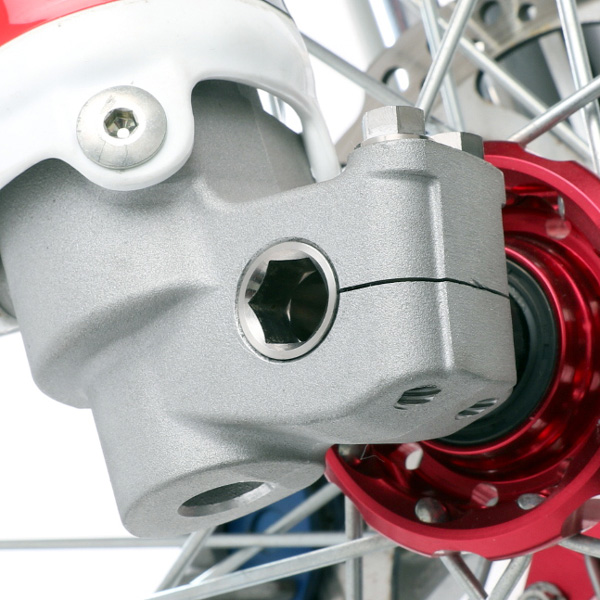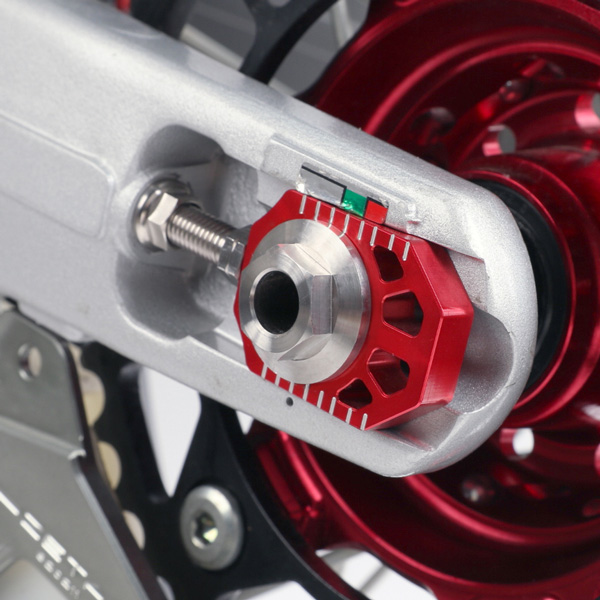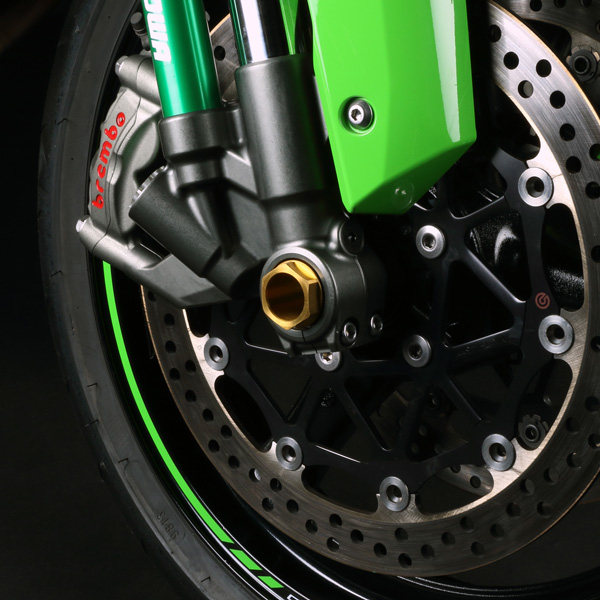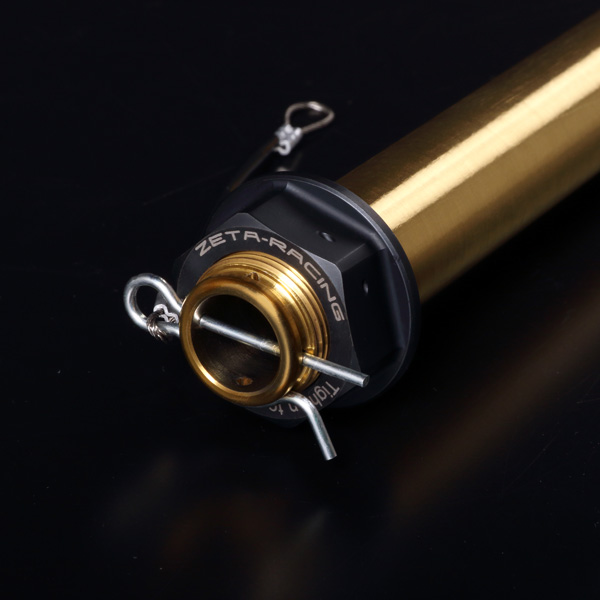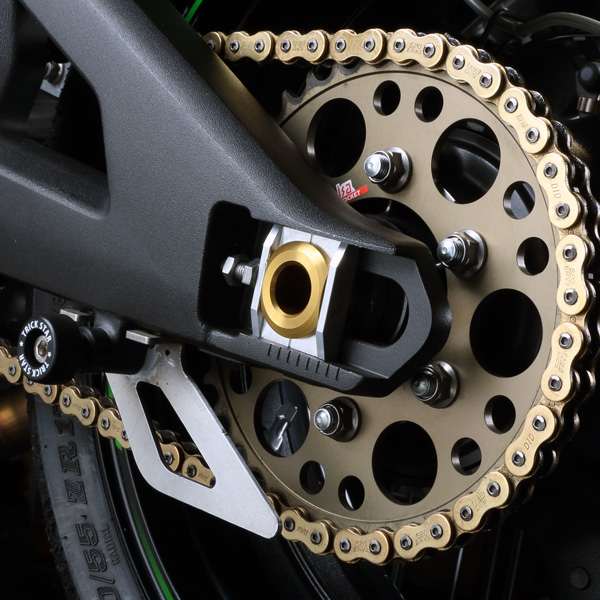- Handlebar
- Handlebar Accessories
- Barclamp
- Lever
- Pedal
- Handguard
- Guard
- Body
- Suspension
- Accessories
- Z-TITANIUM Bolt & Nut
- Z-CARBON
- Z-WHEEL
- ZETA Street

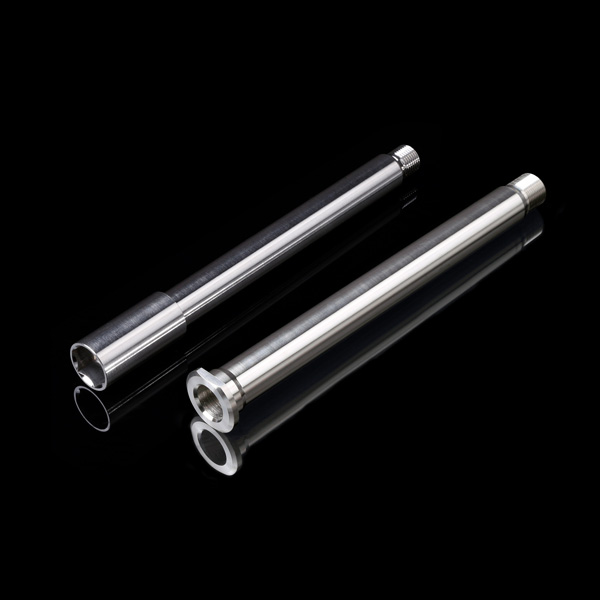
Z-Titanium AXLE SHAFT
LIGHT WEIGHT
The specific gravity of Ti-6AL-4V is about 4.4. This is about 56 % with respect to the specific gravity of 7.8 of stock axle shaft using iron( SS400 ) and carbon steel ( S45C ), or chromium molybdenum steel shaft ( SCM440 ). This means that if you manufacture the axle shaft in the same mass, 64 titanium will be able to produce about 44 % reduction. The reduced weight of the axle shaft also reduces the unsprung weight and corner approaches will improve the handling and stability. In addition, the reduction of unsprung weight will not only improve the movement of the suspension, but also improve brake performance.
ULTRA STRENGTH
Strength of Ti - 6A L- 4V is c omparable to chromium molybdenum steel ( SCM435 ) 900 - 930 Mpa. With the higher strength axle shaf t, you will be able to feel more road sur face informat ion more direct ly. You wi l l be able to sense the bumpy road that could not be felt until now.
BENDING
The Young’s modulus ofTi-6AL-4V is about half of iron and chromium molybdenum steel at 106 Gpa. The Young's modulus represents the rigidity and elasticity, the higher the number, the higher the high rigidity. Generally, one thinks "high-strength = high rigidity,” also 64 titanium has been taken for granted as high rigidity, but actually it is only half the rigidity of iron. Therefore it easily deformed, but there is elastic deformation where a material tries to return to it’s original state and plastic deformation where deformation is permanent. 64 titanium has a wide range of elastic deformation. In other words this is "BENDING". It is this bending that produces the suspension effect, and high strength that softly transmits road surface information.


| Not only Light. Not only strong. Not only flexible. If it is made of aluminum or
magnesium it will be lighter than 64 titanium but it will lack strength. If it is made
of chromium-molybdenum steel and nickel-chromium steel it will be stronger than
64 titanium, but it will be heavy. There is also materials having Young's modulus
lower than 64 titanium, but it will not mean that there is "BENDING.” 64 titanium
is superior to a balance of these materials. Therefore it may be said that it is the
best material for the axle shaft. Also we must not forget the appearance of titanium. It more difficult to rust than stock shaft and chromium-molybdenum steel shaft that has a protective surface treatment. However, it does not escape corrosion where the surface is compromised for some reason. Ti-6AL-4V forms a passive film surface to prevent semipermanent rust to form. |
||||
| Materual | Material symbol and heat treatment | Tensile strength (T/Mpa) |
Young's modulus (E/Gpa) |
Specific gravity |
| Rolled steel for general structure | SS400(Annealing) | 450 | 206 | 7.87 |
| Carbon steel for mechanicalstructure | S45C(Normalizing) | 570 or more | 205 | 7.83 |
| Chromium-molybdenum steel | SCM440 (Tempering quenching) |
980 or more | 206 | 7.86 |
| Austenitic stainless steel | SUS304(Solution treatment) | 520 or more | 197 | 7.93 |
| Pure aluminum | A1085 P(Annealing) | 55 | 69 | 2.7 |
| Duralumin (aluminum alloy) |
A2017 P(Natural aging) | 355 | 69 | 2.79 |
| Ultra duralumin (aluminum alloy) |
A2024 P(Natural aging) | 430 | 74 | 2.78 |
| Extra Ultra duralumin(aluminum alloy) | A7075 P (quench-and-temper) |
573 | 72 | 2.81 |
| Pure titanium (JIS grade1) | TF270 | 275-412 | 106 | 4.51 |
| Pure titanium (JIS grade 2) | TF340 | 343-510 | 106 | 4.51 |
| Pure titanium (JIS grade 3) | TF480 | 481-618 | 106 | 4.51 |
| Titanium (αalloy) | Ti-5AL-2.5Sn | 850 | 118 | 4.48 |
| Titanium (α-βalloy) | Ti-6AL-4V | 900-930 | 106 | 4.43 |
| Titanium (βalloy) | Ti-15Mo-5Zr-3AL | 1470 | 75-95 | 4.8 |













